
The longhorn beetles (Cerambycidae), also known as long-horned or longicorns, are a large family of beetles, with over 35,000 species described.

Batocera is a genus of the family Cerambycidae, subfamily Lamiinae, close to the genus Rosenbergia.

Rutpela maculata, the spotted longhorn, is a beetle species of flower longhorns of the family Cerambycidae, subfamily Lepturinae.
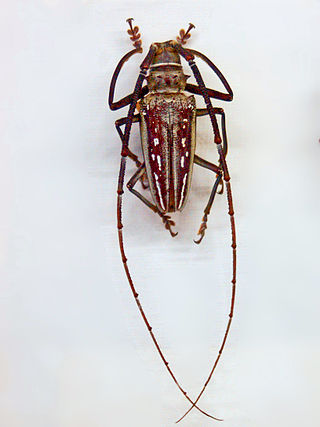
Batocera wallacei, common name Wallace's long-horn beetle, is a species of flat-faced longhorn beetle in the subfamily Lamiinae of the family Cerambycidae. The species name honors Alfred Russel Wallace, who discovered this longhorn beetle on the Aru Islands in Indonesia. It was named after him by James Thomson in 1858.

Batocera laena is a species of flat-faced longhorn beetle in the subfamily Lamiinae of the family Cerambycidae.

Batocera humeridens is a species of flat-faced longhorn beetle in the subfamily Lamiinae of the family Cerambycidae. Found in Timor and nearby islands

Batocera boisduvali, the great fig tree borer, is a species of flat-faced longhorn beetle belonging to the subfamily Lamiinae of the family Cerambycidae.
Pseudestola is a genus of longhorn beetles of the subfamily Lamiinae, containing the following species:
Desisopsis is a genus of longhorn beetles of the subfamily Lamiinae, containing the following species:
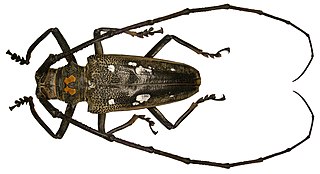
Batocera celebiana is a species of beetle in the family Cerambycidae. It was described by Thomson in 1858. It is known from Java, the Moluccas, and Sulawesi. It contains the subspecies Batocera celebiana pierrotae.

Batocera lineolata is a species of beetle in the family Cerambycidae. It was described by Louis Alexandre Auguste Chevrolat in 1852. It is known from China, Korea, Japan and Taiwan.
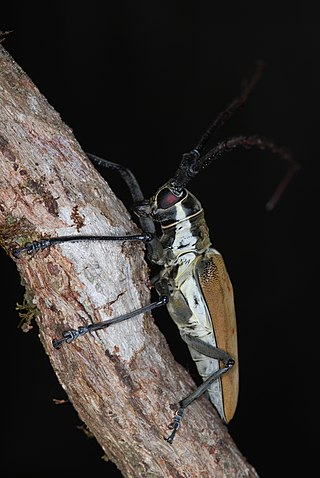
Batocera numitor, the mango-tree longicorn borer, is a species of beetle in the family Cerambycidae. It was described by Newman in 1842. It is known from China, Java, India, Laos, Nepal, Myanmar, the Philippines, Sulawesi, Sri Lanka, Thailand, Sumatra, and Vietnam. It feeds on plants including Mangifera indica and Quercus griffithii.
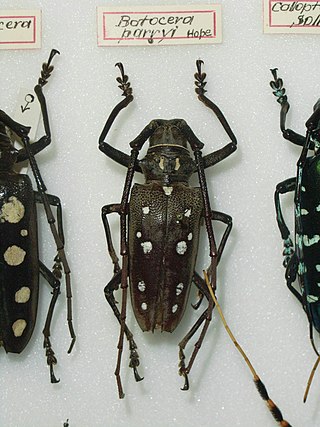
Batocera parryi is a species of beetle in the family Cerambycidae. It was described by Hope in 1845. It is known from China, India, Laos, Java, Myanmar, Malaysia, Sumatra, and Vietnam.

Batocera rubus is a species of beetle in the family Cerambycidae. It was described by Carl Linnaeus in his landmark 1758 10th edition of Systema Naturae. It is known from Japan, China, Java, India, Laos, Myanmar, Malaysia, the Philippines, South Korea, Taiwan, Sumatra, Thailand, and Vietnam. It feeds on Ficus carica, Ficus elastica, and Mangifera indica.
Batocera armata is a species of flat-faced longhorn beetle in the subfamily Lamiinae of the family Cerambycidae. While originally named as "Cerambyx thomae" by Voet in 1778, no name was validly published for this species until 1800; Voet's 1778 work fails to fulfill the requirement in ICZN Article 11.4 that a work must be consistently binomial, and all names within that work are unavailable.

Aristobia reticulator is a species of beetle in the family Cerambycidae. It is known from Bhutan, Myanmar, India, China, Laos, Bangladesh, Thailand, and Vietnam. It feeds on Prunus persica, Liquidambar formosana, Quercus acutissima, Prunus salicina, and Nephelium mutabile. Many references list the name as Aristobia testudo, but this name, though published earlier, is unavailable under the ICZN, primarily in that Johann Eusebius Voet's 1778 work giving the name testudo fails to fulfill the requirement in ICZN Article 11.4 that a work must be consistently binomial; none of Voet's 1778 names, including testudo, are available.
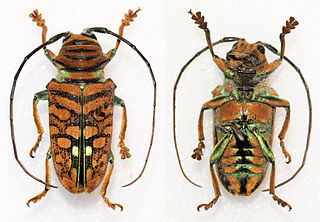
Sternotomis chrysopras is a species of beetle in the family Cerambycidae. It has a wide distribution in Africa. It feeds on Artocarpus altilis, Theobroma cacao, Coffea liberica, and Coffea canephora. While originally named by Voet in 1778, the name was not validly published until 1817. Voet's 1778 work fails to fulfill the requirement in ICZN Article 11.4 that a work must be consistently binomial; none of Voet's 1778 names, including S. chrysopras, are available.

Rutpela is a genus of beetles of flower longhorns belonging to the family Cerambycidae, subfamily Lepturinae.

Euryphagus is a genus of longhorn beetles native to tropical Asia. It is classified in the family Cerambycidae, subfamily Cerambycinae, and the tribe Trachyderini. The generic name is derived from Greek εὐρύς and φαγεῖν referring to the broad mandibles of the males.















